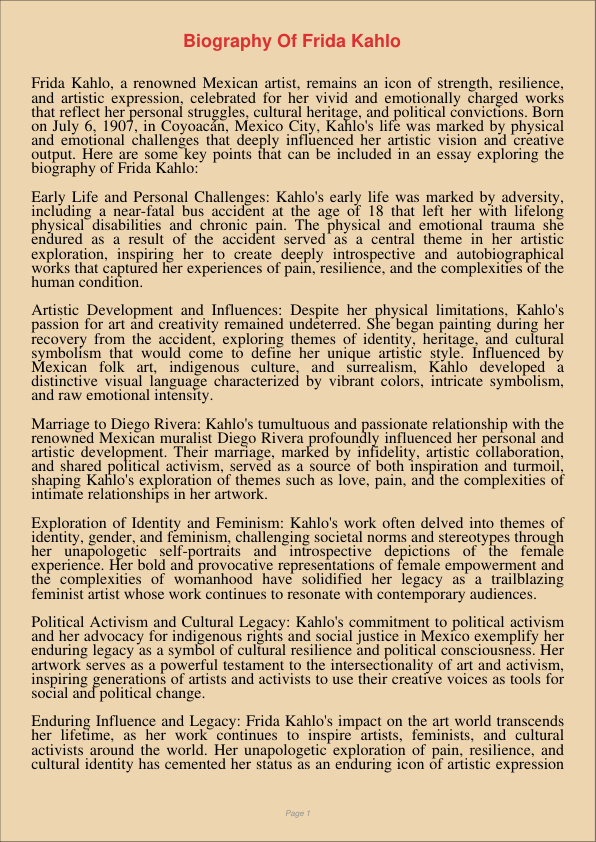Biography Of Frida Kahlo
Jan 7, 2024
frida kahlo
biography
Engineering and Construction
Psychology
Frida Kahlo, a renowned Mexican artist, remains an icon of strength, resilience, and artistic expression, celebrated for her vivid and emotionally charged works that reflect her personal struggles, cultural heritage, and political convictions. Born on July 6, 1907, in Coyoacán, Mexico City, Kahlo’s life was marked by physical and emotional challenges that deeply influenced her artistic vision and creative output. Here are some key points that can be included in an essay exploring the biography of Frida Kahlo:
Early Life and Personal Challenges: Kahlo’s early life was marked by adversity, including a near-fatal bus accident at the age of 18 that left her with lifelong physical disabilities and chronic pain. The physical and emotional trauma she endured as a result of the accident served as a central theme in her artistic exploration, inspiring her to create deeply introspective and autobiographical works that captured her experiences of pain, resilience, and the complexities of the human condition.
Artistic Development and Influences: Despite her physical limitations, Kahlo’s passion for art and creativity remained undeterred. She began painting during her recovery from the accident, exploring themes of identity, heritage, and cultural symbolism that would come to define her unique artistic style. Influenced by Mexican folk art, indigenous culture, and surrealism, Kahlo developed a distinctive visual language characterized by vibrant colors, intricate symbolism, and raw emotional intensity.
Marriage to Diego Rivera: Kahlo’s tumultuous and passionate relationship with the renowned Mexican muralist Diego Rivera profoundly influenced her personal and artistic development. Their marriage, marked by infidelity, artistic collaboration, and shared political activism, served as a source of both inspiration and turmoil, shaping Kahlo’s exploration of themes such as love, pain, and the complexities of intimate relationships in her artwork.
Exploration of Identity and Feminism: Kahlo’s work often delved into themes of identity, gender, and feminism, challenging societal norms and stereotypes through her unapologetic self-portraits and introspective depictions of the female experience. Her bold and provocative representations of female empowerment and the complexities of womanhood have solidified her legacy as a trailblazing feminist artist whose work continues to resonate with contemporary audiences.
Political Activism and Cultural Legacy: Kahlo’s commitment to political activism and her advocacy for indigenous rights and social justice in Mexico exemplify her enduring legacy as a symbol of cultural resilience and political consciousness. Her artwork serves as a powerful testament to the intersectionality of art and activism, inspiring generations of artists and activists to use their creative voices as tools for social and political change.
Enduring Influence and Legacy: Frida Kahlo’s impact on the art world transcends her lifetime, as her work continues to inspire artists, feminists, and cultural activists around the world. Her unapologetic exploration of pain, resilience, and cultural identity has cemented her status as an enduring icon of artistic expression and cultural empowerment, leaving a profound and indelible mark on the history of modern art.
